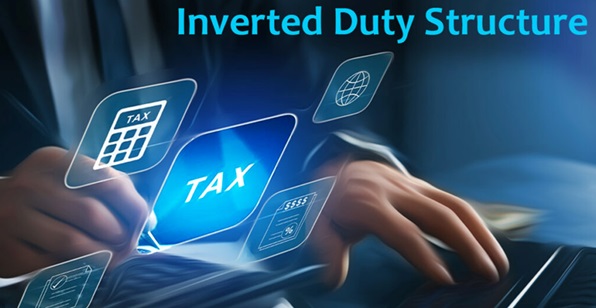
- Inverted Duty Structure (IDS) is a phenomenon within the indirect tax system, particularly under the Goods and Services Tax (GST), where the import duties on raw materials or input goods are higher than the tax rates levied on finished goods.
- This creates a situation where the Input Tax Credit (ITC) accumulated by businesses due to the higher input taxes becomes a liability, as they are unable to offset it with the comparatively lower tax on the final products they sell.
Concept of Inverted Duty Structure (IDS)
- In simple terms, an inverted duty structure occurs when the tax rate on inputs (raw materials) is higher than the tax rate on outputs (finished goods).
- This discrepancy typically happens in a tax system like GST, where businesses are allowed to claim Input Tax Credit (ITC) for taxes paid on inputs to set off against the tax payable on outputs.
Example:
- Suppose the GST on raw materials used in the production of a good is 18%, but the GST on the finished product is 12%. In such cases, the manufacturer pays more tax on inputs than the tax on the final goods.
Resulting in Higher Cost:
- In IDS, businesses end up paying higher taxes for inputs, and thus, the cost of production increases.
- While they can claim the Input Tax Credit (ITC) on those inputs, the unbalanced rate structure causes practical challenges for businesses.
Impact of Inverted Duty Structure (IDS)
Increased Product Costs:
- Since businesses are forced to pay higher taxes on inputs (raw materials) compared to the lower taxes on the final goods, the overall cost of manufacturing increases.
- This is particularly problematic for industries that rely heavily on imported raw materials or products with high tax rates, as the accumulated Input Tax Credit cannot be utilized immediately to offset the tax burden on finished goods.
Competitiveness of Domestic Industry:
- IDS creates challenges for the domestic industry, especially industries that face higher taxes on inputs than on the output products.
- The higher production costs make the final goods more expensive, thereby affecting the competitive edge in both domestic and international markets.
- As a result, exporting goods becomes difficult, as the products produced domestically become costlier in comparison to those produced in other countries with more favourable tax structures.
Cash Flow and Working Capital Issues:
- Under the GST system, businesses generally have the ability to claim an Input Tax Credit (ITC) for the taxes they pay on inputs, which reduces their effective tax liability.
- However, in the case of IDS, the ITC exceeds the tax payable on outputs.
- This excess ITC remains blocked in the electronic credit ledger of businesses, leading to working capital issues.
- Essentially, businesses are unable to utilize the ITC efficiently, which ties up their financial resources.
- These blocked credits may lead to cash flow problems, particularly for businesses that require working capital to meet their operational costs.
Refund-Related Issues:
- In the GST system, businesses facing an inverted duty structure can seek refunds for the unutilized ITC.
- However, refund processing under GST has been a long-standing challenge, with delays and complexity in the system.
- Refund delays can severely impact the liquidity of businesses, creating further financial distress and impacting business operations.
- The government has taken steps to address this, but refund-related issues persist in cases of IDS, adding to the operational complexity and increasing the financial burden.
Examples of Industries Affected by IDS
Textiles Industry:
- In many cases, fabric manufacturing might attract a higher GST rate on inputs (e.g., 18%) compared to finished garments, which could have a lower GST rate (e.g., 12%).
- As a result, textile manufacturers face a situation where they cannot use the Input Tax Credit efficiently, increasing their overall production cost.
Automobile Industry:
- The automobile sector also faces challenges with IDS, particularly in the case of luxury car manufacturing.
- Components or parts used in car production might attract higher taxes compared to the final product itself, making the business less competitive.
Electronic Goods:
- In the case of electronics manufacturing, parts and components (such as microchips, etc.) are often subject to a higher tax rate compared to the finished electronic goods, resulting in higher input costs.
Addressing the Issue of IDS
Policy Adjustments:
- Government Measures: To mitigate the impact of IDS, the Government of India periodically reviews and adjusts tax rates to ensure greater harmony between the tax rates on inputs and outputs.
- GST Rate Rationalization: The GST Council has taken steps in the past to rationalize the tax structure by bringing more goods into the lower tax slabs, and it has also made periodic adjustments to address the issue of inverted duty structures.
Refund Mechanisms:
- Timely Refund Processing: To reduce working capital issues and enhance liquidity, the timely processing of refund claims under the GST regime is a critical factor. Faster refunds can significantly improve the cash flow of businesses facing IDS.
- Special Provisions for Certain Sectors: In some sectors facing severe IDS problems, the government has introduced special provisions or incentives, such as special refund schemes, to reduce the financial burden.


